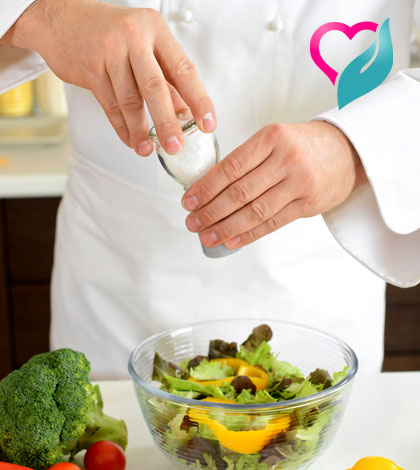Sodium is an important mineral and electrolyte necessary for many functions in the body. It has an important role in maintaining water balance within cells, and is involved in proper functioning of both nerve impulses and muscles within the body.
[wp_ad_camp_1]
Along with potassium, sodium also plays a crucial role in blood pressure regulation. Sodium is only needed in small quantities, and the kidneys are responsible for excreting extra sodium from the body.
Most sodium in the average diet is in the form of salt, which is beneficial in small amounts but can be harmful in large doses. Most people consume about 3,400 milligrams of sodium per day, which is far more than the 1,500 to 2,300 milligrams recommended for a healthy diet. If you eat too much sodium, it begins to build up in your body and can contribute to numerous health conditions.
Fluid Retention
Have you ever noticed that annoying puffy feeling after eating a salty snack? That’s the excess sodium kicking in. Because sodium causes your body to retain fluids. Not only can fluid retention be uncomfortable, it can also be dangerous for your long-term health. Symptoms include swelling of feet, ankles and hands, stiff joints, rapid weight gain, significant weight fluctuations and increased abdominal size. Chronic fluid retention can occur with heart failure, kidney disease, lung disease and arthritis.
[wp_ad_camp_4]
High Blood Pressure
Your kidneys help excrete excess sodium from your body, but when your diet contains too much salt, your kidneys might not be able to get rid of what you don’t need. When your kidneys are unable to efficiently remove sodium from your body, your blood volume increases. An increased blood volume requires your heart to work harder to pump blood throughout your body. When your heart has to work harder, it puts extra pressure on your arteries and causes an increase in blood pressure.
Bloating
Adding salt to your food may make the bloating that you normally experience only before your period an ongoing problem. Sodium helps maintain water balance in your body, and your kidney excretes any excess through your urine. If you consume too much sodium, your kidneys’ work load becomes hefty, reducing their ability to complete the task. This results in retained fluid in your abdominal area.
Weak Bones
Even if you consume plenty of calcium-rich foods, a salt-rich diet increases your risk for osteoporosis, according to studies. Osteoporosis is characterized by weak, brittle bones. For each teaspoon of salt, your body excretes considerable amounts of calcium through urine. Although osteoporosis is less common before menopause, it can affect young women. Poor bone strength early on increases your risk for osteoporosis and fractures later in life.
Kidney Stones
A salty diet can trigger kidney stones, because excess sodium causes minerals to accumulate and form the hard crystals in your urinary tract. If you have other risk factors, such as family history of kidney stones or eat a meat-rich diet, salting your food further raises your risk.
Sources of Sodium
Processed and packaged foods are among the top food sources of sodium. Soy sauce, canned soup, frozen dinners, deli meats, pizza, potato chips and fast food are high in salt added to help preserve them and enhance their flavor. Bread, condiments, cheese and certain snacks are also significant sources of sodium. Vegetables, dairy foods, seafood, saltwater crabs, pickled food and meat contain natural sodium. Though these foods have small amounts of sodium, they still contribute to your total intake. Read food labels to help you determine how much sodium your diet contains. Choose reduced-sodium and low-sodium versions to help cut your total intake.
The Good Side of Sodium
Sodium helps muscles and nerves work properly by assisting muscular contraction and transmission of nerve signals. It also helps regulate blood pressure and volume. Having the proper amount of sodium in the body maintains an appropriate overall balance of bodily fluids. Sodium also helps sustain a regular blood pH level, an important indicator of health
[wp_ad_camp_2]
Ways to Reduce Salt Intake
- Use fresh, rather than packaged, meats. Fresh cuts of beef, chicken or pork contain natural sodium, but the content is still much less than the hidden extra sodium added during processing in products like bacon or ham. If a food item keeps well in the fridge for days or weeks, that’s a tip off that the sodium content is too high.
- Choose fresh fruit and vegetables, as well, since they are very low in sodium. Canned and frozen fruits are also low in sodium.
- Begin reading food labels as a matter of course. Sodium content is always listed on the label. Sometimes the high sugar content in a product like apple pie can mask the high sodium content so it’s important to check every label for sodium content.
- Compare various brands of the same food item until you find the one that has the lowest sodium content, since this will vary from brand to brand.
- Select spices or seasonings that do not list sodium on their labels, i.e., choose garlic powder over garlic salt.
- Before dining out, do your research. Visit the restaurant’s website which should list the sodium content of various dishes served there. Alternatively, when you’re at the restaurant and ready to order, you can request that the dish be served without salt.
- Beware of products that don’t taste especially salty but still have high sodium content, such as cottage cheese.
- If you have elevated blood pressure, dietary sodium restriction can not only lower your blood pressure, but can enhance your response to blood pressure medications.
- Salt preference is an acquired taste that can be unlearned. It takes about 6-8 weeks to get used to eating food with much lower quantities of salt, but once it’s done, it is actually difficult to eat foods like potato chips because they taste way too salty.
[wp_ad_camp_3]
Image courtesy: saltsense.co.uk , janeshealthykitchen.com




























